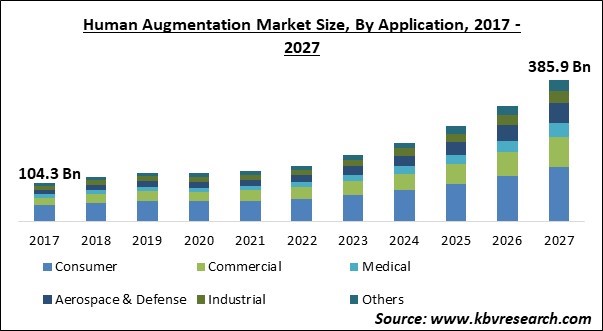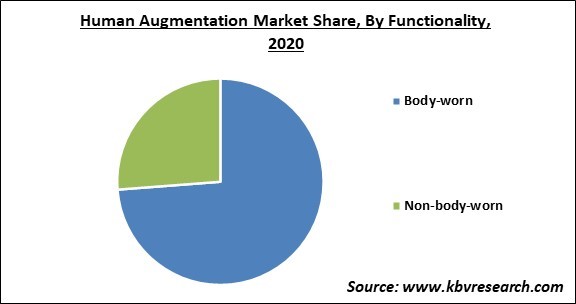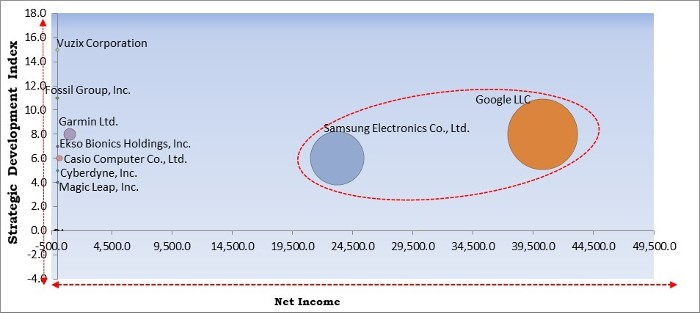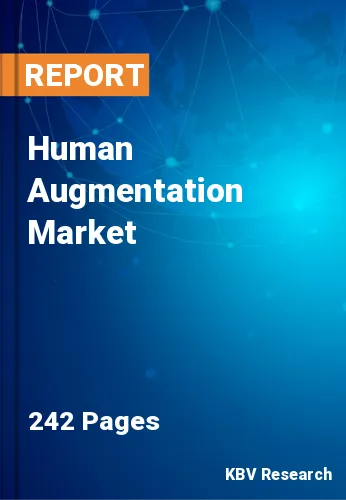The Global Human Augmentation Market size is expected to reach $385.9 billion by 2027, rising at a market growth of 18.8% CAGR during the forecast period.
Human development is a branch of study that seeks to increase human capabilities with medication or innovation at this period. Modern technological breakthroughs have resulted in the emergence of human augmentation, thereby enhancing the way people accomplish things and interpret their surroundings. Expanded capacities have also been achieved using external tools, for instance, eyeglasses, optics, magnifying lenses, or many more cutting-edge technologies that may readily provide a person with a seamless experience.
Beginning with efforts to increase physical capabilities, advances in microelectronics enabled new applications like cognitive and sensory enhancements, would provide human augmentation a significant boost. Hearing aids for persons with auditory difficulties and augmented reality glasses for object identification and navigation support are examples of small electronic devices that can help people with specialised activities.
In general, electronic devices for enhanced human systems use various communication technologies to focus on daily routines and tasks. Enhanced wearable gadgets powered by the Internet of Things, on the other hand, ensure higher applications for physical enhancement, mental help, and advanced sensing. The notion of human augmentation encompasses a wide range of aspects, from mental to physical, all of which are tied to a certain purpose or technology.

COVID-19 has resulted in a worldwide health disaster and multiple deaths. Lockdowns were implemented in various places, causing supply chain disruptions. The advent of the pandemic had a significant impact on key human augmentation product producers throughout the first two quarters of 2020. Exoskeletons, AR and VR equipment like projectors & display walls, head-mounted displays, and gesture-tracking gadgets have all been affected by the supply chain interruptions due to the pandemic. During the initial phase, the market saw a decrease in shipments.
Regardless of its impact on the overall economy, the COVID-19 had no negative impact on the wearable device sector. Despite the fact that certain market competitors reduced their manufacturing, sales for wearables continued to rise significantly. Many market participants began creating new and improved items to fulfill rising demand and new needs. The rising necessity to track health issues as a result of the pandemic, as well as the growing use of such devices among health-conscious consumers, fuelled market expansion. The market's growth has been aided by the rising demand for smart wearables that can monitor heart rate and oxygen levels.
Many people have benefited from human enhancement, which has helped them withstand physical stress and regain physical or psychological capacities. Human health and quality of life have improved as a result of technological developments in the fields of neurology, engineering, biotechnology, and computing. Human expectation of new technology has risen dramatically, and as a result, the healthcare industry is fast evolving. In the health and fitness industries, innovative and advanced technology is being embraced at a quicker rate.
There is a wide range of benefits offered by human augmentation technologies to various business and entities. Military powers can employ AR to develop MRO by superimposing advanced data into a client's real-world vision via a virtual sphere. It's for distinguishing visual abilities that are essential in 3D. In architecture, PC programming must include actual conveniences and be free of cameras or images. It integrates 3D models of an introduced structure into space using 3D models in cell phones, in addition to expanded reality field administrations.
The lack of movement when wearing various AR/VR headsets is a fundamental problem connected with immersive user experiences. Many wired headsets need the usage of cords and accessories to connect to the PC while in use, requiring the user to remain stationary for an extended period of time. Due to the lack of mobility, this causes back, neck, and joint discomfort. The poor resolution of VR-enabled gadgets is another drawback. Low quality makes viewing difficult and might exacerbate virtual sickness symptoms like discomfort and nausea.

On the basis of Functionality, the Human Augmentation Market is segmented into Body-worn and Non-body-worn. The non-body worn segment procured a substantial revenue share in the human augmentation market in 2020. The increased need for immersive content for VR and AR devices for entertainment and gaming uses is predicted to fuel overall growth for VR and AR software, as well as non-body-worn devices. In recent times, intelligent virtual assistants like chatbots have been increasingly used to improve customer support services, resulting in enhanced customer loyalty, conversion rate, retention, and reduced shopping cart abandonment.
Based on the Product, the Human Augmentation Market is segmented into Wearable Devices, Virtual Reality Devices, Augmented Reality Devices, Exoskeletons, and Intelligent Virtual Assistants. The wearable devices segment dominated the human augmentation market with the highest revenue share in 2020. It is due to the increased usage of wearable devices to track health and fitness metrics. Furthermore, the advancement of tiny multifunctional ICs and improved sensor technologies has aided the development of low-cost wearable devices for a variety of consumer applications.
In terms of Application, the Human Augmentation Market is categorized into Consumer, Commercial, Medical, Aerospace & Defence, Industrial, and Others. The commercial segment garnered a significant revenue share in the human augmentation market in 2020. This growth is attributed to the fact that these technologies can help the IC better time, tailor, and target intelligence products for key decision makers by expanding, automating, and sharpening intelligence collection and processing insights.
| Report Attribute | Details |
|---|---|
| Market size value in 2020 | USD 130.7 Billion |
| Market size forecast in 2027 | USD 385.9 Billion |
| Base Year | 2020 |
| Historical Period | 2017 to 2019 |
| Forecast Period | 2021 to 2027 |
| Revenue Growth Rate | CAGR of 18.8% from 2021 to 2027 |
| Number of Pages | 242 |
| Number of Tables | 391 |
| Report coverage | Market Trends, Revenue Estimation and Forecast, Segmentation Analysis, Regional and Country Breakdown, Competitive Landscape, Companies Strategic Developments, Company Profiling |
| Segments covered | Functionality, Product Type, Application, Region |
| Country scope | US, Canada, Mexico, Germany, UK, France, Russia, Spain, Italy, China, Japan, India, South Korea, Singapore, Malaysia, Brazil, Argentina, UAE, Saudi Arabia, South Africa, Nigeria |
| Growth Drivers |
|
| Restraints |
|
Region-wise, the Human Augmentation Market is studied across North America, Europe, APAC, and LAMEA. North America emerged as the leading region in human augmentation market with the highest revenue share in 2020. This is owing to the region's improving economy and rising demand for enhancement products. Furthermore, technical improvements in medical wearable products have fuelled market expansion in this region.
Free Valuable Insights: Global Human Augmentation Market size to reach USD 385.9 Billion by 2027

The major strategies followed by the market participants are Product Launches. Based on the Analysis presented in the Cardinal matrix; Samsung Electronics Co., Ltd. and Google LLC are the forerunners in the Human Augmentation Market. Companies such as Ekso Bionics Holdings, Inc., Magic Leap, Inc. and Garmin Ltd. are some of the key innovators in the Market.
The market research report covers the analysis of key stake holders of the market. Key companies profiled in the report include Ekso Bionics Holdings, Inc., Cyberdyne, Inc., Magic Leap, Inc., ReWalk Robotics Ltd., Samsung Electronics Co., Ltd. (Samsung Group), Google LLC, Garmin Ltd., Casio Computer Co., Ltd., Fossil Group, Inc., and Vuzix Corporation.
By Functionality
By Product Type
By Application
By Geography
The human augmentation market size is projected to reach USD 385.9 billion by 2027.
Increasing demand for wearable augmentation devices in healthcare industry are driving the market in coming years, however, health apprehensions pertaining to AR and VR technologies have limited the growth of the market.
Ekso Bionics Holdings, Inc., Cyberdyne, Inc., Magic Leap, Inc., ReWalk Robotics Ltd., Samsung Electronics Co., Ltd. (Samsung Group), Google LLC, Garmin Ltd., Casio Computer Co., Ltd., Fossil Group, Inc., and Vuzix Corporation.
The Body-worn market is generating high revenue in the Global Human Augmentation Market by Functionality 2020, thereby, achieving a market value of $268.3 Billion by 2027.
The Virtual Reality Devices market shows highest growth rate of 17.9% during (2021 - 2027).
The North America market is the fastest growing region in the Global Human Augmentation Market by Region 2020, and would continue to be a dominant market till 2027.
Our team of dedicated experts can provide you with attractive expansion opportunities for your business.

